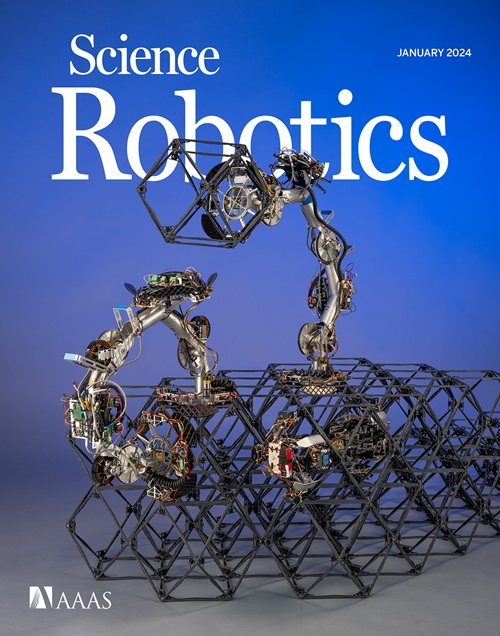具有多模式运动的微型深海变形机器人
IF 27.5
1区 计算机科学
Q1 ROBOTICS
引用次数: 0
摘要
微型深海机器人的研究是一个新兴领域,其重点是开发能够与深海独特环境和生物相互作用的可展开、紧凑的设备。在这项研究中,我们提出了一种厘米级深海软致动器的设计策略,该致动器重16克,包含双稳性手性超材料和管密封形状记忆合金。根据我们的设计,利用静水压力引起的模量增加来实现双稳手性单元更高的抓取速度,从而提高执行器的性能。结果表明,该驱动器可以在深海的不同深度产生不失真的循环运动。随后,我们开发了一种无系绳微型深海机器人,通过改变其腿和鳍的用途,能够进行多模式运动。为了验证机器人的性能,这个微型机器人从深海潜水器上部署,在海马冷渗(1380米深)和马里亚纳海沟(10600米深)进行游泳、滑翔、变形和爬行;随后,潜水器将其完整地打捞上来。驱动模块的设计使机器人在海马冷渗和实验室水缸条件下(大气压)的性能相当。此外,我们还开发了一种基于相同超材料设计策略的可穿戴软爪,以促进安全的深海作业,从软标本收集到重物操作(~3400米深)。这项研究为创造下一代微型深海驱动器和机器人提供了设计见解,为未来的探索和与深海生态系统的互动铺平了道路。本文章由计算机程序翻译,如有差异,请以英文原文为准。
Miniature deep-sea morphable robot with multimodal locomotion
Research on miniature deep-sea robots is an emerging field focused on the development of deployable, compact devices capable of interacting with the unique environments and organisms of the deep ocean. In this study, we present a design strategy for a centimeter-scale deep-sea soft actuator, weighing 16 grams, that incorporates bistable chiral metamaterials and tube-sealed shape memory alloys. According to our design, the increased modulus induced by the hydrostatic pressure was used to achieve a higher snapping velocity of the bistable chiral unit, thus lifting the actuator’s performance. We showed that the actuator can produce undistorted cyclic motions at various depths in the deep sea. Subsequently, we developed an untethered miniature deep-sea robot that is capable of multimodal locomotion by repurposing its legs and fins. To validate the robot’s performance, this miniature robot was deployed from deep-sea crewed submersibles, performing swimming, gliding, morphing, and crawling in the Haima Cold Seep (1380-meter depth) and the Mariana Trench (10,600-meter depth); it was then retrieved by the submersible fully intact. The actuation module design enabled the robot to perform comparably in the Haima Cold Seep and laboratory aquarium conditions (atmospheric pressure). Additionally, we developed a wearable soft gripper based on the same metamaterial design strategy to facilitate safe deep-sea operations, ranging from soft-specimen collection to heavy-object manipulation (~3400-meter depth). This study offers design insights into creating next-generation miniature deep-sea actuators and robots, paving the way for future exploration and interaction with deep-sea ecosystems.
求助全文
通过发布文献求助,成功后即可免费获取论文全文。
去求助
来源期刊

Science Robotics
Mathematics-Control and Optimization
CiteScore
30.60
自引率
2.80%
发文量
83
期刊介绍:
Science Robotics publishes original, peer-reviewed, science- or engineering-based research articles that advance the field of robotics. The journal also features editor-commissioned Reviews. An international team of academic editors holds Science Robotics articles to the same high-quality standard that is the hallmark of the Science family of journals.
Sub-topics include: actuators, advanced materials, artificial Intelligence, autonomous vehicles, bio-inspired design, exoskeletons, fabrication, field robotics, human-robot interaction, humanoids, industrial robotics, kinematics, machine learning, material science, medical technology, motion planning and control, micro- and nano-robotics, multi-robot control, sensors, service robotics, social and ethical issues, soft robotics, and space, planetary and undersea exploration.
 求助内容:
求助内容: 应助结果提醒方式:
应助结果提醒方式:


